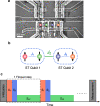Floquet-enhanced spin swaps
- PMID: 33837187
- PMCID: PMC8035411
- DOI: 10.1038/s41467-021-22415-6
Floquet-enhanced spin swaps
Abstract
The transfer of information between quantum systems is essential for quantum communication and computation. In quantum computers, high connectivity between qubits can improve the efficiency of algorithms, assist in error correction, and enable high-fidelity readout. However, as with all quantum gates, operations to transfer information between qubits can suffer from errors associated with spurious interactions and disorder between qubits, among other things. Here, we harness interactions and disorder between qubits to improve a swap operation for spin eigenstates in semiconductor gate-defined quantum-dot spins. We use a system of four electron spins, which we configure as two exchange-coupled singlet-triplet qubits. Our approach, which relies on the physics underlying discrete time crystals, enhances the quality factor of spin-eigenstate swaps by up to an order of magnitude. Our results show how interactions and disorder in multi-qubit systems can stabilize non-trivial quantum operations and suggest potential uses for non-equilibrium quantum phenomena, like time crystals, in quantum information processing applications. Our results also confirm the long-predicted emergence of effective Ising interactions between exchange-coupled singlet-triplet qubits.
Conflict of interest statement
The authors declare no competing interests.
Figures





References
-
- Arute F, et al. Quantum supremacy using a programmable superconducting processor. Nature. 2019;574:505–510. - PubMed
-
- Pal A, Huse DA. Many-body localization phase transition. Phys. Rev. B. 2010;82:174411.
-
- Khemani V, Lazarides A, Moessner R, Sondhi SL. Phase structure of driven quantum systems. Phys. Rev. Lett. 2016;116:250401. - PubMed
-
- Else DV, Bauer B, Nayak C. Floquet time crystals. Phys. Rev. Lett. 2016;117:090402. - PubMed
Grants and funding
- D18AC00025,/United States Department of Defense | Defense Advanced Research Projects Agency (DARPA)
- W911NF16-1-0260/United States Department of Defense | United States Army | U.S. Army Research, Development and Engineering Command | Army Research Office (ARO)
- W911NF-19-1-0167/United States Department of Defense | United States Army | U.S. Army Research, Development and Engineering Command | Army Research Office (ARO)
LinkOut - more resources
Full Text Sources
Other Literature Sources

